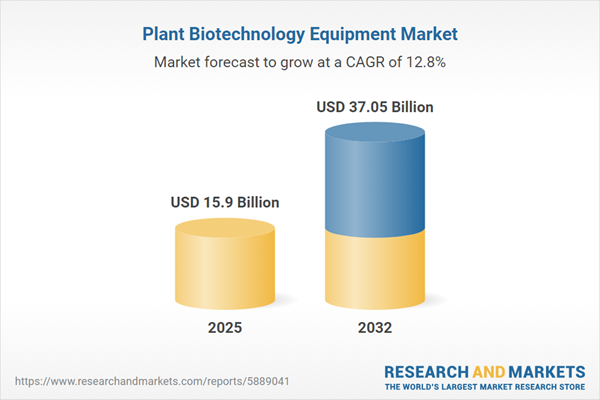Speak directly to the analyst to clarify any post sales queries you may have.
The plant biotechnology equipment market is experiencing accelerated transformation, driven by innovations in research workflows and mounting priorities around sustainability and collaboration. Strategic investments in next-generation technologies and careful adaptation to evolving regulatory and supply chain pressures are shaping an agenda for forward-thinking leaders in this vital sector.
Market Snapshot: Plant Biotechnology Equipment Market Overview
The global plant biotechnology equipment market grew from USD 14.12 billion in 2024 to USD 15.90 billion in 2025 and is projected to reach USD 37.05 billion by 2032, with a compound annual growth rate (CAGR) of 12.81%. This market expansion is propelled by the widespread adoption of precision gene editing, advanced sequencing platforms, automated phenotyping, and eco-conscious equipment design. Senior decision-makers are increasingly focused on balancing innovative capability with compliance, efficiency, and environmental responsibility.
Scope & Segmentation of the Plant Biotechnology Equipment Market
This report offers a comprehensive analysis of key plant biotechnology equipment segments and global regions, providing actionable insights across the following areas:
- Instrument Types: Bioreactors (single use and stainless steel), DNA sequencers (next generation and Sanger), microarray systems (for gene expression profiling and SNP analysis), and PCR systems (digital PCR and qPCR).
- Applications: Gene editing solutions using CRISPR, TALEN, and ZFN; genetic analysis methods including expression analysis and genotyping; phenotyping approaches featuring image analysis and sensor-based tools; and tissue culture processes such as callus and protoplast culture.
- Technologies: CRISPR tools (plasmid delivery, ribonucleoprotein), next generation sequencing platforms (notably Illumina, Ion Torrent), and PCR technologies (ddPCR, qPCR).
- End Users: Academic institutions (research centers, universities), biotech companies (agri-biotech, pharma-biotech), contract research organizations (clinical CRO, CRO services), and pharmaceutical companies (biologics, small molecule).
- Workflow Stages: Analysis activities (bioinformatics, data visualization), sample preparation (DNA extraction, library preparation), and synthesis (gene synthesis, oligo synthesis).
- Regional Coverage: Americas (North America including United States, Canada, Mexico; Latin America with Brazil, Argentina, Chile, Colombia, Peru), Europe, Middle East & Africa (notably United Kingdom, Germany, France, Russia, Italy, Spain, Netherlands, Sweden, Poland, Switzerland; Middle East including UAE, Saudi Arabia, Qatar, Turkey, Israel; Africa with South Africa, Nigeria, Egypt, Kenya), and Asia-Pacific (China, India, Japan, Australia, South Korea, Indonesia, Thailand, Malaysia, Singapore, Taiwan).
- Key Competitors: The competitive landscape covers major industry players such as Thermo Fisher Scientific Inc., Danaher Corporation, Merck KGaA, Agilent Technologies, Inc., PerkinElmer, Inc., Sartorius AG, Bio-Rad Laboratories, Inc., Waters Corporation, Shimadzu Corporation, and Tecan Group Ltd.
Key Takeaways & Strategic Insights
- Rapid advances in gene editing and high-throughput sequencing are transforming research cycles and expanding the capabilities of plant science teams.
- Automation, digital integration, and green chemistry principles are increasingly essential for efficient, reproducible, and sustainable laboratory processes.
- Regional market maturity varies considerably, requiring tailored strategies and technology deployment to meet divergent regulatory, funding, and infrastructural requirements.
- Demand is consolidating around flexible, modular equipment architectures and workflow-specific solutions that support evolving laboratory needs across academia, biotech, and pharma sectors.
- Service-based business models, including leasing, instrument rental, and advanced maintenance plans, are gaining traction as organizations seek to optimize both uptime and budget flexibility.
- Differentiation now also depends on support systems, with emphasis on training, remote diagnostics, and optimized data pipelines that enhance customer value.
Tariff Impact: Evolving Supply Chains and Innovation Pathways
The 2025 imposition of tariffs on United States imports has prompted manufacturers to reconfigure supply chains, shift toward regional assembly, and adopt multi-source procurement. This regulatory environment is stimulating domestic investment in manufacturing, driving deeper collaboration between industrial and academic partners, and increasing the focus on supply chain resilience. Market participants are also intensifying resource sharing to accelerate development and optimize distribution logistics.
Methodology & Data Sources
This report employs a rigorous methodology grounded in both primary and secondary research. Inputs include expert interviews with key market participants, comprehensive analysis of scientific literature, industry filings, and patent activity. Quantitative findings have been validated through data triangulation, cross-referencing, and workshops with technical experts, ensuring accuracy and credibility for decision-makers.
Why This Report Matters
- Uncovers actionable intelligence for navigating technology adoption, policy shifts, and procurement trends in the plant biotechnology equipment market.
- Enables benchmarking of regional and application-specific opportunities for market entry, partnership, or expansion.
- Supports informed investment and R&D planning with segmented data and analysis tailored to senior leadership priorities.
Conclusion
The plant biotechnology equipment sector is characterized by rapid transformation, regional diversification, and a shift toward integrated and sustainable solutions. Strategic collaboration and flexible, modular approaches are key for organizations looking to capitalize on the next wave of industry evolution.
Additional Product Information:
- Purchase of this report includes 1 year online access with quarterly updates.
- This report can be updated on request. Please contact our Customer Experience team using the Ask a Question widget on our website.
Table of Contents
3. Executive Summary
4. Market Overview
7. Cumulative Impact of Artificial Intelligence 2025
Companies Mentioned
The companies profiled in this Plant Biotechnology Equipment market report include:- Thermo Fisher Scientific Inc.
- Danaher Corporation
- Merck KGaA
- Agilent Technologies, Inc.
- PerkinElmer, Inc.
- Sartorius AG
- Bio-Rad Laboratories, Inc.
- Waters Corporation
- Shimadzu Corporation
- Tecan Group Ltd.
Table Information
| Report Attribute | Details |
|---|---|
| No. of Pages | 189 |
| Published | October 2025 |
| Forecast Period | 2025 - 2032 |
| Estimated Market Value ( USD | $ 15.9 Billion |
| Forecasted Market Value ( USD | $ 37.05 Billion |
| Compound Annual Growth Rate | 12.8% |
| Regions Covered | Global |
| No. of Companies Mentioned | 11 |









